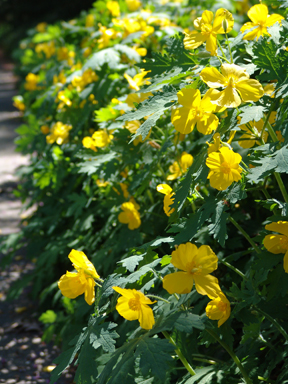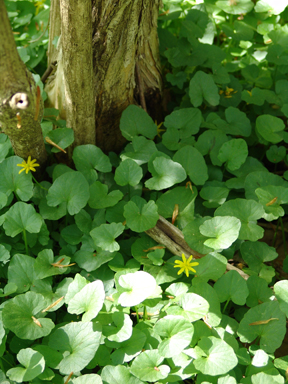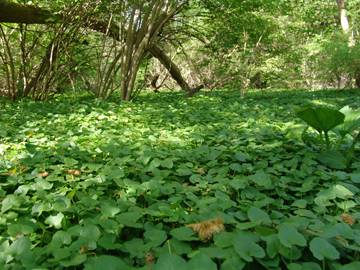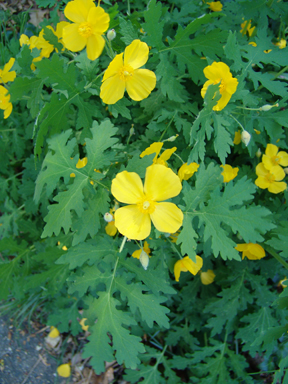Confusion over Celandine
While giving a tour during Swarthmore College’s Family Weekend, I was questioned about a lovely little yellow-flowering groundcover in the garden. The visitor knew that one type of yellow flowering groundcover blooming this time of year was an invasive and should be removed immediately and another was a native to our woodland and should be allow to self seed into the garden. She knew she had either the invasive lesser celandine, Ranunculus ficaria, or the native celandine poppy, Stylophorum diphyllum, in her garden. The difference can easily be distinguished between the two plants if you know what you are looking at.
Ranunculus ficaria is a carpet-like groundcover with heart-shaped leaves which flowers with buttercup-like flowers in March and April. Lesser celandine creates a mat of vegetation often in floodplain areas preventing other native plants from emerging and sprouting in the spring. The foliage dies back in mid-summer leaving bare ground until it reemerges in early spring. Vast swathes of this plant can be seen along Crum Creek.
It is believed this invasive was introduced as an ornamental plant from Europe, as European horticulturists have been developing cultivars since the late 1500s. When removing this garden thug, be sure to dig up all the small bulblets to prevent its return.
Stylophorum diphyllum also sports a yellow flower in April, but the foliage it distinctly different. Celandine poppy or wood poppy has deeply incised, hairy leaves – reminiscent of an oak leaf. A native of the United States this perennial grows well in shade to part-sun and favors a woodland setting with rich soils along steam banks. The foliage of S. diphyllum does not create the same matting effect as R. ficaria, thus it doesn’t prevent the emergence of the other spring ephemerals.
S. diphyllum also produces an attractive bristly fruit for garden interest. The foliage will disappear by mid-summer like R. ficaria. There is lovely stand along the Cedar Lane sidewalk on the outskirts of the Cherry Border.
If you have R. ficaria in your garden, be sure to dig it out while the vegetation is still visible. If you have S. diphyllum enjoy the color and texture it brings to the garden by allowing it to naturalize.









Jon
Posted at 11:30h, 05 MayThanks for the post. However, isn’t the harder distinction between our native Stylophorum diphyllum and the introduced Chelidonium majus?
Jan Semler
Posted at 14:13h, 05 MayI was given a ‘Wood Poppy’ as a gift several years ago, and purchased two more last year. It is happy in my shade garden and is naturalizing nicely. A bit of sun in the shade!
Andrew Bunting
Posted at 15:28h, 05 MayStylophorum has broader leaves and Chelidonium leaves are more dissected. Also, the flowers are smaller on Chelidonium. However, they are visually very similar.
Andrew Bunting, Curator
John Manion
Posted at 09:12h, 07 MayTo see an excellent example of one of this plant’s mechanisms for seed dispersal, open a ripe seed pod. Attached to each seed will be a lighter-colored appengage attached, called an eliasome.. Ants favor these protein-rich tidbits for larval food and after carrying the seeds back to their underground condominiums, they feed the eliasome to their larvae and dispose of the seed in their compost piles, where it will germinate.
Julie Vrooman
Posted at 17:56h, 07 MayA former Arboretum intern taught me to distinguish Stylophorum from Chelidonium by the seed pods. The former being a rounded oval, and the later being long and thin – a little like garlic mustard.
Hi John! That’s intersting about the ants. I will be on the lookout.
Vince
Posted at 11:04h, 08 AprilI read that the eggs of walking stick insects look similar to seeds, complete with the something that resembles the eliasome that John mentioned. So the ants also carry them into their “condominiums” where they remain protected until they hatch.
I can’t remember where I read this… now I have to look it up to confirm.
John Bickel
Posted at 14:24h, 11 AprilHi Vince, that’s true about the walking stick eggs! Apparently, its not all species of Phasmatodea (stick insects) that exhibit the myrmecochorous mimicry, but a select few species including the common North American walkingstick (Diapheromera femorata). According to my sources, the eggs, which are very seed-like, have a knob on the end called a capitulum which exudes a fatty substance that is very similar to an elaiosome. The ants will take the egg to their nest and consume the capitulum while the embryo remains unaffected and the egg overwinters and hatches in the ant nest. It’s amazing that all of the phases of the insect’s life cycle are so deeply tied to plant mimicry! Thanks for the comment!
John Bickel
Assistant Horticulturist
Toru Knives
Posted at 02:28h, 11 OctoberWonderful article! We are linking to this great article on our site.
Keep up the good writing.